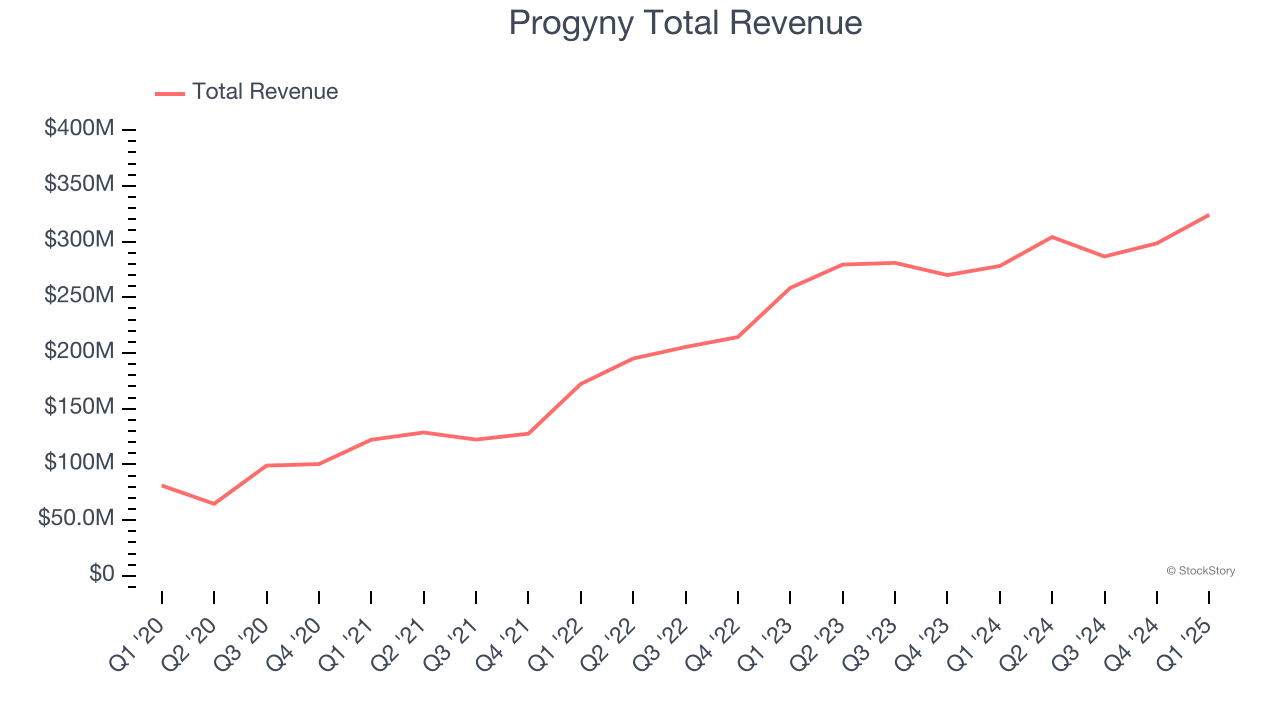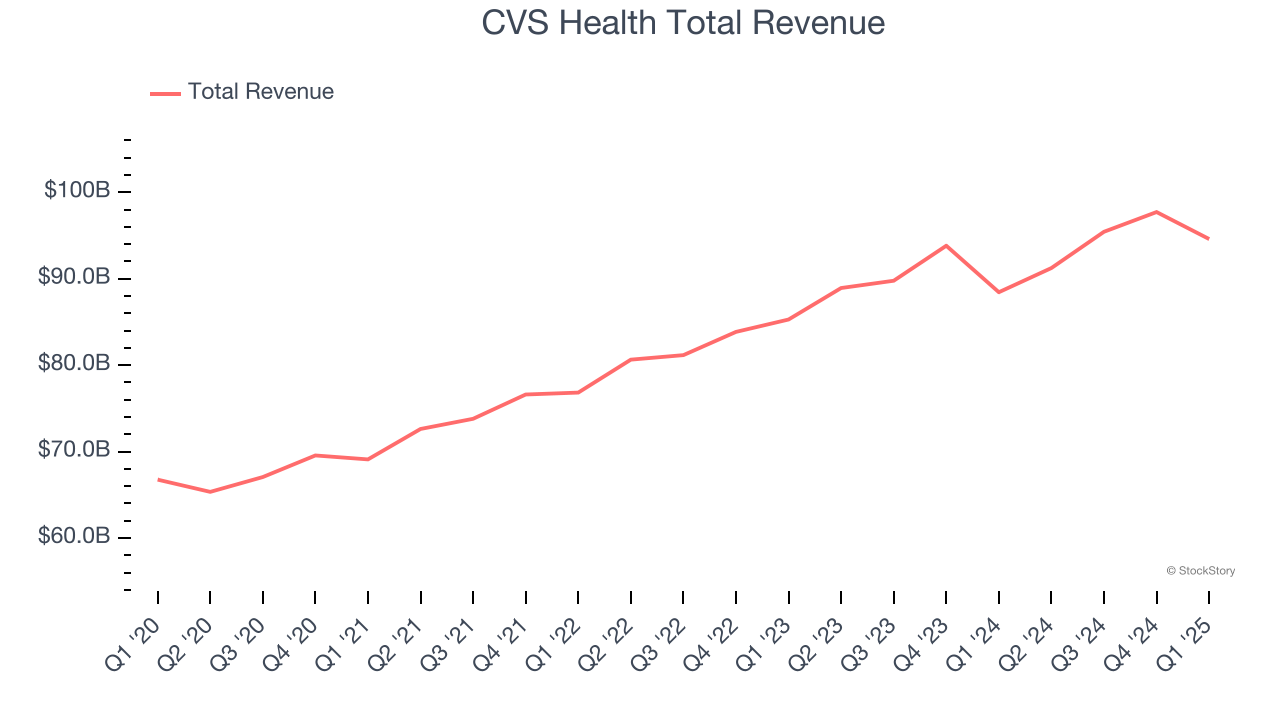
Looking back on health insurance providers stocks’ Q1 earnings, we examine this quarter’s best and worst performers, including Progyny (NASDAQ:PGNY) and its peers.
Upfront premiums collected by health insurers lead to reliable revenue, but profitability ultimately depends on accurate risk assessments and the ability to control medical costs. Health insurers are also highly sensitive to regulatory changes and economic conditions such as unemployment. Going forward, the industry faces tailwinds from an aging population, increasing demand for personalized healthcare services, and advancements in data analytics to improve cost management. However, continued regulatory scrutiny on pricing practices, the potential for government-led reforms such as expanded public healthcare options, and inflation in medical costs could add volatility to margins. One big debate among investors is the long-term impact of AI and whether it will help underwriting, fraud detection, and claims processing or whether it may wade into ethical grey areas like reinforcing biases and widening disparities in medical care.
The 11 health insurance providers stocks we track reported a strong Q1. As a group, revenues beat analysts’ consensus estimates by 3% while next quarter’s revenue guidance was in line.
Amidst this news, share prices of the companies have had a rough stretch. On average, they are down 8.4% since the latest earnings results.
Progyny (NASDAQ:PGNY)
Pioneering a data-driven approach to family building that has achieved an industry-leading patient satisfaction score of +80, Progyny (NASDAQ:PGNY) provides comprehensive fertility and family building benefits solutions to employers, helping employees access quality fertility treatments and support services.
Progyny reported revenues of $324 million, up 16.5% year on year. This print exceeded analysts’ expectations by 5%. Overall, it was a satisfactory quarter for the company with an impressive beat of analysts’ sales volume estimates.
“We're pleased with the strong start to the year, highlighted by both our solid financial results as well as the progress made with our investments to expand the platform and extend our leading position as the solution of choice in women's health and family building,” said Pete Anevski, Chief Executive Officer of Progyny.

Progyny delivered the weakest full-year guidance update of the whole group. Unsurprisingly, the stock is down 10% since reporting and currently trades at $21.03.
Is now the time to buy Progyny? Access our full analysis of the earnings results here, it’s free.
Best Q1: CVS Health (NYSE:CVS)
With over 9,000 retail pharmacy locations serving as neighborhood health destinations across America, CVS Health (NYSE:CVS) operates retail pharmacies, provides pharmacy benefit management services, and offers health insurance through its Aetna subsidiary.
CVS Health reported revenues of $94.59 billion, up 7% year on year, outperforming analysts’ expectations by 1.5%. The business had an exceptional quarter with an impressive beat of analysts’ same-store sales estimates and a solid beat of analysts’ EPS estimates.

Although it had a fine quarter compared to its peers, the market seems unhappy with the results as the stock is down 6.5% since reporting. It currently trades at $62.36.
Is now the time to buy CVS Health? Access our full analysis of the earnings results here, it’s free.
Weakest Q1: UnitedHealth (NYSE:UNH)
With over 100 million people served across its various businesses and a workforce of more than 400,000, UnitedHealth Group (NYSE:UNH) operates a health insurance business and Optum, a healthcare services division that provides everything from pharmacy benefits to primary care.
UnitedHealth reported revenues of $109.6 billion, up 9.8% year on year, falling short of analysts’ expectations by 1.7%. It was a softer quarter as it posted a significant miss of analysts’ full-year EPS guidance estimates and a slight miss of analysts’ EPS estimates.
UnitedHealth delivered the weakest performance against analyst estimates in the group. The company added 395,000 customers to reach a total of 54.12 million. As expected, the stock is down 50.9% since the results and currently trades at $287.66.
Read our full analysis of UnitedHealth’s results here.
Alignment Healthcare (NASDAQ:ALHC)
Founded in 2013 with a mission to transform healthcare for seniors, Alignment Healthcare (NASDAQ:ALHC) provides Medicare Advantage health plans for seniors with features like concierge services, transportation benefits, and technology-driven care coordination.
Alignment Healthcare reported revenues of $926.9 million, up 47.5% year on year. This number beat analysts’ expectations by 4.4%. Overall, it was a very strong quarter as it also put up a solid beat of analysts’ EPS estimates.
Alignment Healthcare achieved the fastest revenue growth among its peers. The company added 28,400 customers to reach a total of 217,500. The stock is down 10.2% since reporting and currently trades at $15.00.
Read our full, actionable report on Alignment Healthcare here, it’s free.
Cigna (NYSE:CI)
With roots dating back to 1792 and serving millions of customers across the globe, The Cigna Group (NYSE:CI) provides healthcare services through its Evernorth Health Services and Cigna Healthcare segments, offering pharmacy benefits, specialty care, and medical plans.
Cigna reported revenues of $65.5 billion, up 14.4% year on year. This result surpassed analysts’ expectations by 8.4%. More broadly, it was a satisfactory quarter as it also recorded a decent beat of analysts’ EPS estimates but a significant miss of analysts’ customer base estimates.
Cigna scored the biggest analyst estimates beat among its peers. The company lost 1.14 million customers and ended up with a total of 16.36 million. The stock is down 5.3% since reporting and currently trades at $317.
Read our full, actionable report on Cigna here, it’s free.
Market Update
Thanks to the Fed’s rate hikes in 2022 and 2023, inflation has been on a steady path downward, easing back toward that 2% sweet spot. Fortunately (miraculously to some), all this tightening didn’t send the economy tumbling into a recession, so here we are, cautiously celebrating a soft landing. The cherry on top? Recent rate cuts (half a point in September 2024, a quarter in November) have propped up markets, especially after Trump’s November win lit a fire under major indices and sent them to all-time highs. However, there’s still plenty to ponder — tariffs, corporate tax cuts, and what 2025 might hold for the economy.
Want to invest in winners with rock-solid fundamentals? Check out our 9 Best Market-Beating Stocks and add them to your watchlist. These companies are poised for growth regardless of the political or macroeconomic climate.
Join Paid Stock Investor Research
Help us make StockStory more helpful to investors like yourself. Join our paid user research session and receive a $50 Amazon gift card for your opinions. Sign up here.
